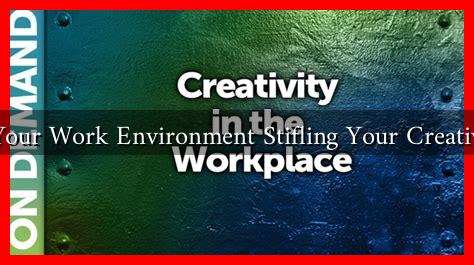-
Table of Contents
Is Your Work Environment Stifling Your Creativity?
In today’s fast-paced world, creativity is often heralded as a key driver of innovation and success. However, many individuals find that their work environments can be a significant barrier to creative thinking. This article explores how various aspects of the workplace can stifle creativity and offers insights into fostering a more innovative atmosphere.
The Impact of Physical Space on Creativity
The design and layout of a workspace can greatly influence an employee’s ability to think creatively. Research has shown that environments that are too rigid or uninspiring can lead to decreased motivation and creativity. According to a study by the University of Exeter, employees in well-designed workspaces are 15% more productive than those in poorly designed environments.
- Open vs. Closed Spaces: Open-plan offices are often touted for their collaborative potential, but they can also lead to distractions and noise, which may hinder creative thought. Conversely, private spaces can provide the quiet needed for deep thinking.
- Color and Decor: The colors and decor of a workspace can evoke different emotions. For instance, blue is often associated with calmness and focus, while yellow can stimulate creativity. A bland, monochromatic office may not inspire innovative thinking.
- Nature Elements: Incorporating elements of nature, such as plants or natural light, has been shown to enhance creativity. A study published in the Journal of Experimental Psychology found that exposure to nature can improve cognitive function and creativity.
Cultural Factors That Inhibit Creativity
Beyond the physical space, the culture of an organization plays a crucial role in fostering or stifling creativity. A culture that discourages risk-taking or punishes failure can create an environment where employees are afraid to share their ideas.
- Fear of Criticism: When employees fear negative feedback, they are less likely to propose innovative ideas. A supportive culture that encourages constructive criticism can help mitigate this fear.
- Lack of Autonomy: Micromanagement can stifle creativity by limiting employees’ ability to explore their ideas. Providing autonomy allows individuals to take ownership of their projects and think outside the box.
- Rigid Hierarchies: Organizations with strict hierarchies may inhibit the free flow of ideas. Encouraging open communication across all levels can foster a more creative environment.
Examples of Creative Work Environments
Several companies have successfully created work environments that promote creativity. For instance, Google is renowned for its innovative workspace design, which includes open areas, relaxation zones, and even nap pods. This approach has contributed to their reputation as a leader in creativity and innovation.
Another example is IDEO, a design and consulting firm known for its human-centered, design-based approach. IDEO’s office is designed to encourage collaboration and experimentation, with spaces that can be easily reconfigured for different projects.
Statistics on Creativity in the Workplace
Understanding the importance of creativity in the workplace is supported by various statistics:
- According to a survey by Adobe, 80% of professionals believe that unlocking creativity is critical to economic growth.
- A study by the World Economic Forum found that creativity will be one of the top three skills needed in the workforce by 2025.
- Research from the University of Michigan indicates that employees who feel their work environment supports creativity are 30% more likely to be engaged in their work.
Strategies to Enhance Creativity in the Workplace
To combat the stifling effects of a non-conducive work environment, organizations can implement several strategies:
- Encourage Collaboration: Create opportunities for team brainstorming sessions and cross-departmental projects.
- Provide Flexibility: Allow employees to choose their workspaces or work hours to suit their creative processes.
- Invest in Training: Offer workshops and training sessions focused on creative thinking and problem-solving skills.
Conclusion
In conclusion, the work environment plays a pivotal role in shaping an individual’s creative output. By recognizing the factors that stifle creativity—such as physical space, organizational culture, and management styles—companies can take proactive steps to foster a more innovative atmosphere. As creativity becomes increasingly essential in the modern workforce, investing in a supportive environment is not just beneficial; it is imperative for long-term success.
For further reading on enhancing creativity in the workplace, consider exploring resources from Forbes.

